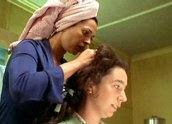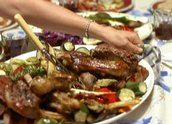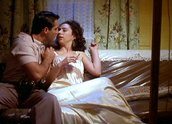


La Spagnola (2001)
Synopsis
Australia in 1960. Teenage Lucia’s life is shattered when her father Ricardo (Simon Palomares) walks out on the family to shack up with a buxom blonde Australian woman. He leaves behind a desolate house in the shadow of a big refinery and his pregnant wife Lola (Lola Marceli), who can’t speak English. They are the only Spanish family in a community of Italian migrants. Lucia (Alice Ansara) has to translate for the teachers at school, and for the patients of a local Australian doctor (Tony Barry), who keeps her mother supplied with sleeping pills. In her anger and grief, Lola aborts her pregnancy with a knitting needle.
When she wakes up in hospital, her husband is dead, killed in an accident. Lucia and Lola have no money, no food and no prospects. To feed the guests after the funeral, Lola’s sister Manola (Lourdes Bartolomé) kills Lucia’s pet goat, Elvis. This is after her mother has already killed and eaten her father’s homing pigeons. Lucia’s hatred of her mother is now complete, although they are united in their hatred for Wendy (Helen Thomson), the Australian woman who’s driving the new car left behind by Ricardo. Lucia sabotages the car on the day that Wendy marries the factory boss. Lola steals the car from outside the church. When the brakes fail, she is almost killed. Lucia leaves home. A few years later she returns with a new car, a gift for her mother.
Curator’s notes
La Spagnola is a comedy, but close enough to tragedy as to be almost indistinguishable at times. The comedy allows the writer, Anna-Maria Monticelli, to explore some very dark material, and the tragic effect is further blunted by exaggerating the sense of memory. There is no voice-over, but the heightened realism and recurring use of sleep and dreams give the film a quality of dimly remembered experience – a veil of poetic imagination. The script is exuberantly, shockingly female. The men in the film are little better than beasts, driven by a desire for sex without responsibility – but the women are crafty, scheming, creative and capable of extreme malice. At the same time they’re driven by passion and desire and a desperate will to survive. Lola has been through a war in Spain and she knows that people are capable of anything, in the right circumstances.
A number of animals are killed in the reign of terror that follows the father’s departure – the pigeons go first, in Lola’s desire to eat and wreak vengeance; the goat follows, in a manoeuvre that’s calculated to turn Lucia against her exuberant aunt Manola. These episodes are treated as black comedy, a reminder of the peasant origins of Lola and her sister, who grew up in a poor country where animals are grown to be eaten, not taken as pets. There are two other deaths that are not treated as comedy – Lola’s terrible self-inflicted abortion, another almost unbearable act of vengeance, and the off-screen death of Ricardo, in an accident that’s never fully explained. Lucia is growing up surrounded by death in the first half of the film; in the second half, the accent shifts to sex, both because Lucia is herself maturing, and because her mother has no qualms about using her body to pay the rent.
The writer, Anna-Maria Monticelli, came to Australian from Rome as a teenager in the 1960s, so a lot of the film is based on personal experience, but she has said it was a difficult film to get financed. She and her husband, actor Steve Jacobs, approached many producers, most of whom were reluctant to deal with the film’s controversial material. In the end they produced it themselves, with Jacobs making his debut as director. The film remains outside the mainstream of Australian cinema – and even most other migrant stories – but it has a comic energy and pungency that’s hard to dismiss, with powerful central performances. Lola Marceli had done mostly television in Spain before this, but Alice Ansara was an 18-year-old newcomer. Both give remarkable performances.
- Overview
- Curator’s notes
- Video 3 clips
- Principal credits
- Find a copy
- Make a comment
- Map
- Add your review



